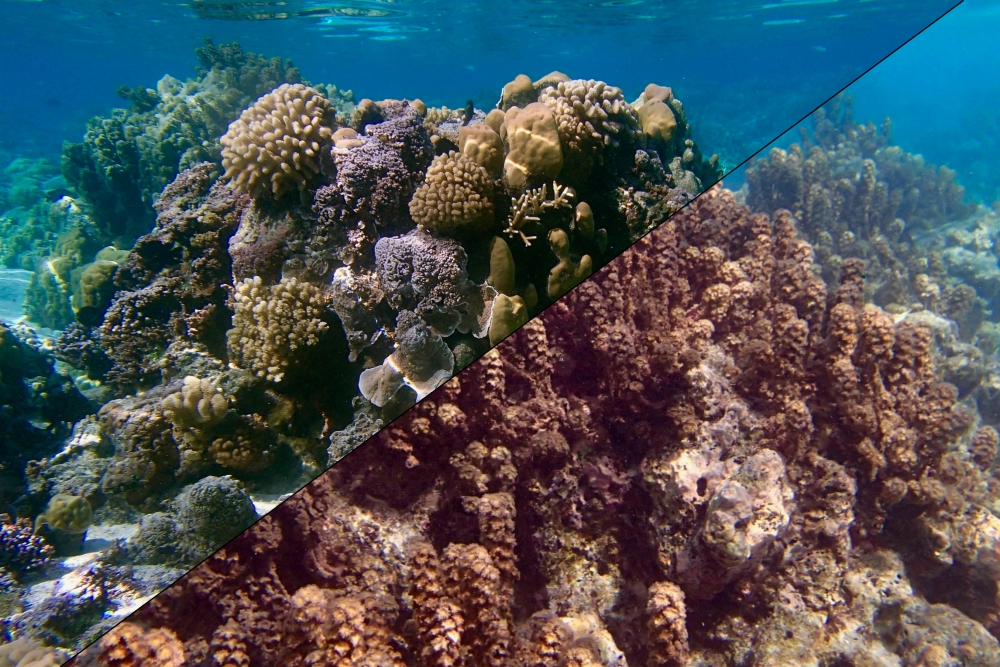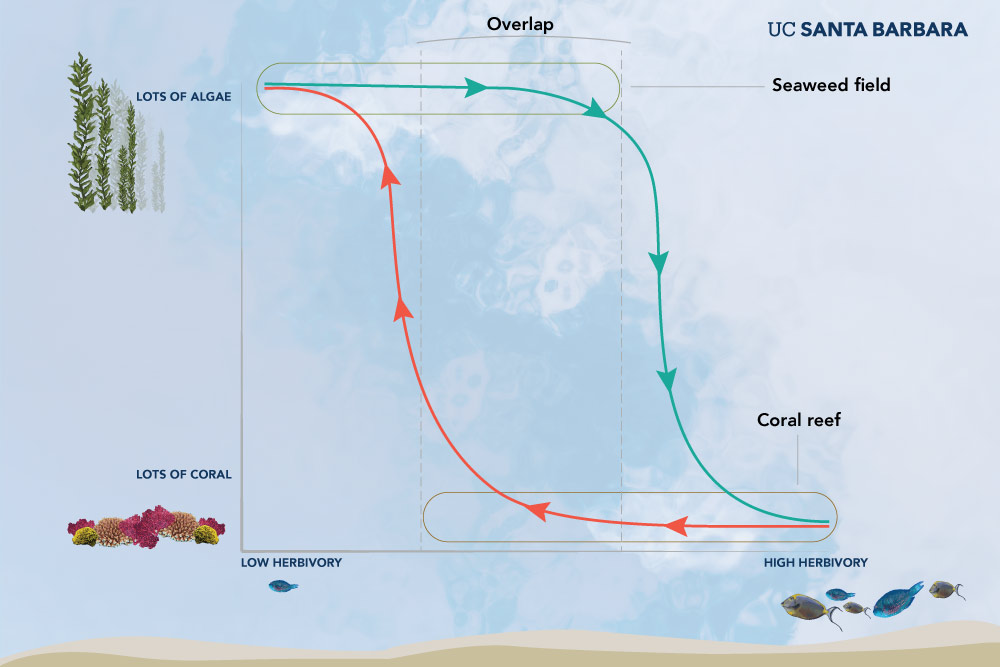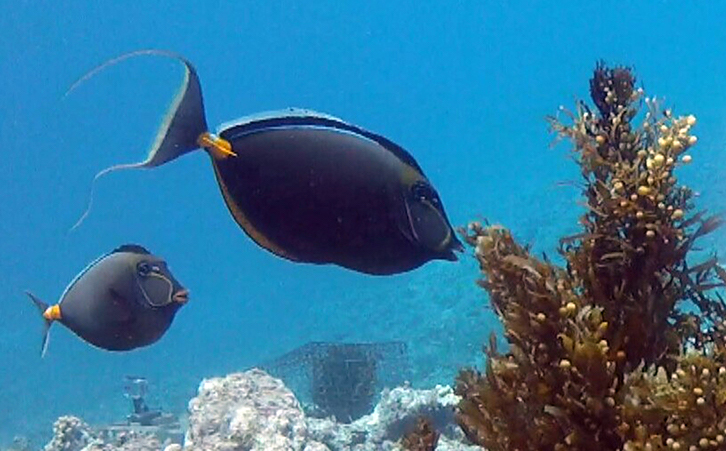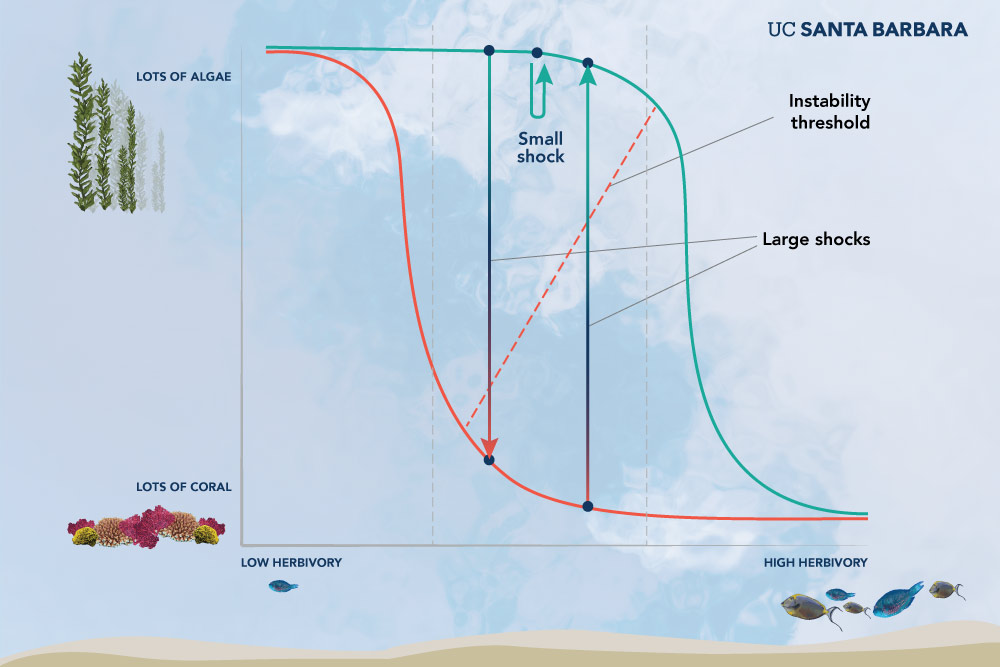
How to Flip a Coral Reef
Tropical reefs are vulnerable ecosystems, sensitive to a variety of environmental conditions and disturbances, which can change their composition from vibrant coral reefs to vast fields of seaweed or barren rubble.
Now researchers at UC Santa Barbara have established that these distinctly different communities can persist under the exact same conditions. The findings, which appear in the Proceedings of the National Academy of Sciences, could have broad implications for ecology and conservation worldwide.
Macroalgae, commonly called seaweed, tends to outcompete coral on reefs unless it’s kept in check by herbivores. As a result, the amount of herbivory on a reef is a strong factor in determining whether the site will be a coral reef or a field of seaweed.
“Reefs in many parts of the world have switched from corals to seaweeds, and the question is what keeps the reef dominated by seaweed rather than returning to coral,” said Professor Sally Holbrook of UC Santa Barbara’s Marine Science Institute (MSI), one of the paper’s coauthors.
One possibility is that the environment changed in a way that favors the seaweed, and so even if the seaweed disappeared, the new conditions would no longer suit coral. But the researchers wanted to determine whether there might be another explanation, one with very different implications for coral reef management. They explored whether a robust coral community and a robust seaweed community could both occur and persist under the same environmental conditions — namely the amount of herbivory on the reef.

If you start off with lots of algae (green curve), it takes more herbivory to transition to a coral-dominated community. If you start out with coral (orange curve) then the coral will remain even under lower levels of herbivory.
Photo Credit: MATT PERKO
In experiments at the National Science Foundation-funded Moorea Coral Reef Long Term Ecological Research site on Moorea, French Polynesia, the group first investigated whether there was a level of herbivory at which both coral and algae could persist on the reef, called a bi-stable region. And if this were the case, they wanted to determine where this window lay in comparison to current conditions on the reef.
The researchers decreased herbivore activity to different levels by caging off certain areas of the reef so fish couldn’t get in to nibble at the algae. They set up cages about the size of a toaster-oven, in groups, on areas that initially either had or didn’t have seaweed. Each group had cages with a variety of hole sizes that created a gradient from sites scarcely accessible to any herbivores, to those that accommodated all but the largest algae eaters.
This setup allowed the research team to determine what levels of herbivory prevented seaweed from taking hold, as well as what levels were needed to remove existing seaweed. They discovered that the flip did not occur under the same conditions going both ways.
“We found it takes far more herbivory to remove seaweed than it does to prevent it,” said lead author Russ Schmitt, also with MSI, and a professor in the Department of Ecology, Evolution and Marine Biology. “This means there’s an amount of herbivory where the habitat could persist either as a coral reef or as a seaweed-dominated reef depending on whether the community started out as coral or seaweed. Nothing else has to differ.”

An orange-spine unicornfish browses on some sargassum, with the experimental cages visible in the background.
Photo Credit: RUSS SCHMITT
Since the experiment spanned several years, the team was able to demonstrate that their results held over multiple generations of seaweed. “This is the first time that a field experiment has shown it’s possible for two different, persistent communities to exist under the same conditions on a coral reef,” said Schmitt.
And the results are more than academic. “One reason this finding is important is that it suggests a big shock to the reef can flip it from coral to seaweed without any change in the amount of herbivory,” said coauthor Samantha Davis, the undergraduate research programs coordinator at the university’s Center for Science and Engineering Partnerships. “And once flipped, the reef then will stay dominated by seaweed.”
MSI Research Scientist Thomas Adam, another of the paper’s coauthors, agrees. “The flip is hard to reverse because only a very large disturbance might cause the reef to return to coral,” he said. “Our second field experiment tested this idea.”
The idea is that if conditions were in this bi-stable region, then after a small shock the community should return to its previous state. A large shock, on the other hand, would change the paradigm under which the system operated, sending it toward a different composition, where it would then remain.

In the region where the two states overlap, a large shock — like a cyclone — can change the behavior of the system even if conditions — like herbivory — remain the same.
Photo Credit: MATT PERKO
The team simulated an event like a cyclone by scrubbing algae off small patches of the lagoon reef, a section they had determined was in this overlapping region of stability. And the reef behaved just like the model predicted. Untouched areas remained in their initial seaweed state, while moderately disturbed areas returned to seaweed fields and stayed that way for years. However, reefs subjected to a more drastic disturbance flipped to a seaweed-free state, which allowed coral to take hold. Except for the different disturbances at the start of the experiment, the environmental conditions were the same across all the sites.
This dynamic presents two challenges for conservation. First, it demonstrates that restoring an altered system to its previous state — like rehabilitating a seaweed-covered lagoon into a thriving coral reef — is more difficult than simply maintaining a community in its initial condition. Second, it suggests that even a seemingly healthy ecosystem could be vulnerable to dramatic shifts in its community. Without changing the conditions on the reef, a large enough jolt to the system could shift an ecosystem into another state, where it will then remain trapped.
Fortunately, the study’s methodology itself offers a powerful tool for determining how vulnerable an ecosystem may be to switching from one state to another, as well as for assessing how difficult it may be to reverse such a switch. “The methods that we developed provide a roadmap for assessing where an ecosystem lies on an environmental gradient — in our case differing levels of herbivory — in relation to a tipping point where the ecosystem may flip from one persistent state to another,” said MSI Project Scientist Andrew Brooks, also a coauthor. It also allows them to determine whether this tipping point lies in a region of bi-stability.
“Coral reefs are slipping away,” said Dan Thornhill, a National Science Foundation Long-Term Ecological Research program director. “We’re seeing a global shift from vibrant coral reef ecosystems to seaweed fields. But these scientists show that under the right conditions, reefs can rebound from disturbance.”



